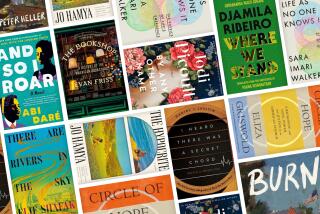Critics’ Choice 1986 : The best books of 1986? The Times asked its regular book reviewers to choose one or two titles each to carry away into 1987. Here are the results.
- Share via
Carolyn See: At first glance, my two favorite books of 1986 seemed satisfyingly different: David Freeman’s “A Hollywood Education: Tales of Movie Dreams and Easy Money” (Putnam’s) was fiction, medium-sized, and--as the author himself had remarked, with ingenuous modesty--aimed only at a “skinny truth.” Robert Hughes’ “The Fatal Shore” (Knopf) was nonfiction, large in size and scope; its stated ambition--to cover 80 years of Australia’s convict history was prodigious--even overweening.
But the two turn out to be startlingly similar. Of course, Freeman’s was set up “here,” and Hughes’ down “there,” but both books took a look at parts of society that had never been fully seen before--in much the same way that Van Gogh looked at the South of France, saw it, translated it for the rest of us, and set it squarely into the bank of human knowledge. In all the hundreds of stories about Hollywood, only Freeman had ever placed, for instance, an avant garde artist, a right-wing stuntman and a brush fire within the same fictional matrix. The experiment turned out to be magic. And for more than a century, Australia’s amazing convict history had lain locked away, waiting for a writer’s magic touch. Hughes--with his consuming interest, his pure love of story, his elegant prose style--was the perfect man for the job. (The publication date for “The Fatal Shore” has been postponed until January of next year; what was a 1986 treat for me gets to be a 1987 New Year’s present for you.)
Lee Dembart: Richard Dawkins’ “The Blind Watchmaker: Why the Evidence of Evolution Reveals a Universe Without Design” (Norton) continues to reverberate in my mind’s ear. As its subtitle clearly announces, this book explains why the argument from design for the existence of God is wrong. That is, a complete explanation of the complexity we see in the world around us does not require the existence of a creator.
What makes the book so memorable, though, is not the argument but the power of Dawkins’ prose. Every sentence is crystal clear. They are authoritative but conversational, and you can hear Dawkins’ British accent in his writing. Not just the choice of words, mind you, but their pronunciation as well.
Charles Champlin: Welsh poet Dylan Thomas revealed his brief, incandescent, alcohol-fueled life in more than 1,000 letters. Collected and edited by Paul Ferris in “Dylan Thomas: The Collected Letters” (Macmillan), they are as zesty and engrossing as any biography (although Ferris himself wrote a good one). The young Thomas conducts an elaborate seduction by post, the riper Thomas courts the famous with flattery and trumpets his publications, the harrassed householder with wife and child wheedles jobs, advances and loans and, increasingly, desperately, tries to explain deadlines missed and appointments not kept. But first and last, he is the dedicated, professional poet, soul-deep in his love of words, and terrified in the end that his gift has begun to fail him.
Elaine Kendall: Wittier than a text, more useful than a memoir, “Subsequent Performances” (Viking) is a one-volume adventure in aesthetics. Jonathan Miller not only discusses theater but brings his knowledge of painting, sculpture, music, science and history to bear on the more general theme of how a work of art can be interpreted after its original context has changed and the specific social conditions present at the time of its creation no longer apply. How much liberty does a director have? Is he within his rights to reset Hamlet in Malibu, to turn King Lear into a victim of Alzheimer’s disease, have Chekhov’s Three Sisters yearn for a Park Avenue co-op? Is the text of a play merely “a Rorschach ink blot into whose indeterminate outlines the director can project whatever he wants?” What are his responsibilities to the original, his obligations to a contemporary audience, his duties to the artist? With authority agreeably tempered by modesty, Miller tackles these problems case by case, candidly citing his rare failures as well as his celebrated successes. Entertaining, enlightening and direct, Miller treats the reader as a colleague, inviting our participation in the dialogue.
Richard Eder: If I had invented dynamite and made so much money out of it that I wanted to invent two literary prizes, I would like to give them to:
“Monkeys” (Dutton) by Susan Minot. It is a chronicle of the rise and fall, not so much of the fortunes of a large and untidy family, as of the magical belief that every real family possesses. The children are witnesses, victims and participants in Rose Marie Vincent’s efforts to bring life and warmth into the house, and Augustus Vincent’s compulsion to remove the windows and let them out again. The nine short stories, though written and published separately, fit together not merely logically, but emotionally. They are cool and sometimes funny, but they are a lament, and their grief is both particular and universal.
“The Real Life of Alejandro Mayta” by Mario Vargas Llosa (Farrar, Straus & Giroux). As in “The War at the End of the World,” Vargas Llosa shows an unmatched ability to turn his vision of Latin America’s climate of social and political extremity into stunning literature. This story of a quixotic and disastrously incompetent revolutionary is absorbing, moving and extraordinarily wise.
More to Read
Sign up for our Book Club newsletter
Get the latest news, events and more from the Los Angeles Times Book Club, and help us get L.A. reading and talking.
You may occasionally receive promotional content from the Los Angeles Times.







